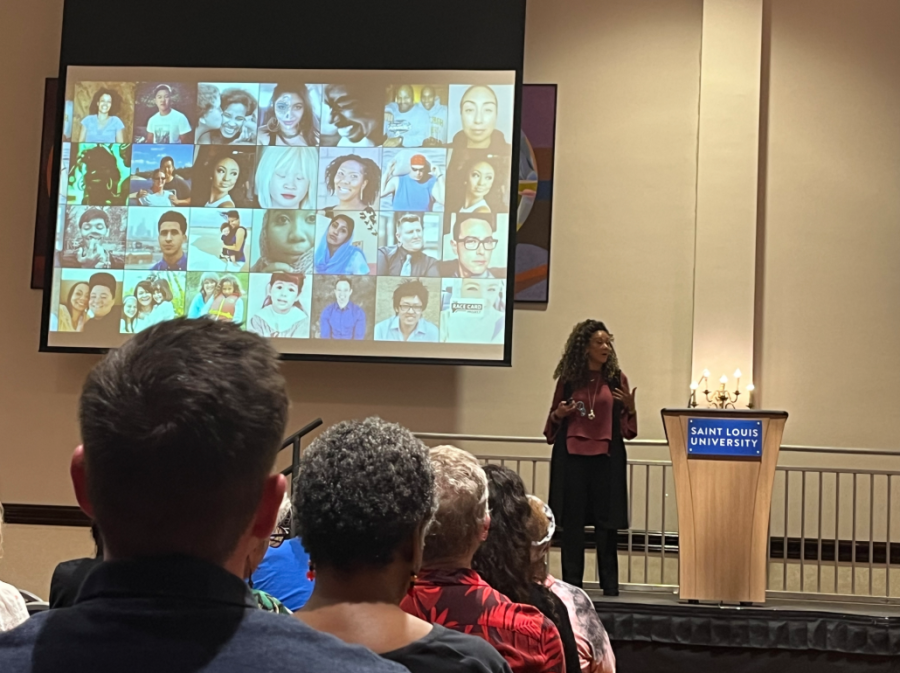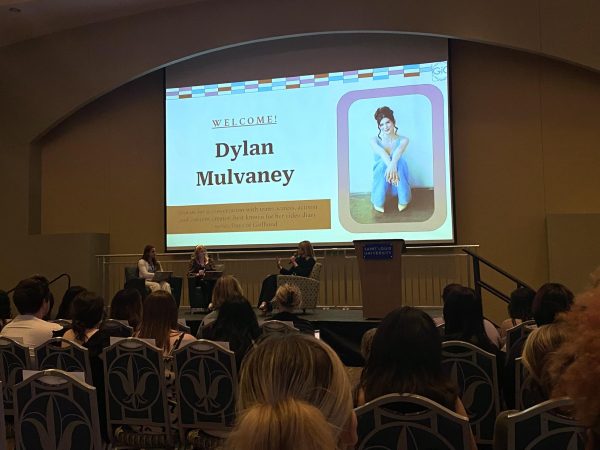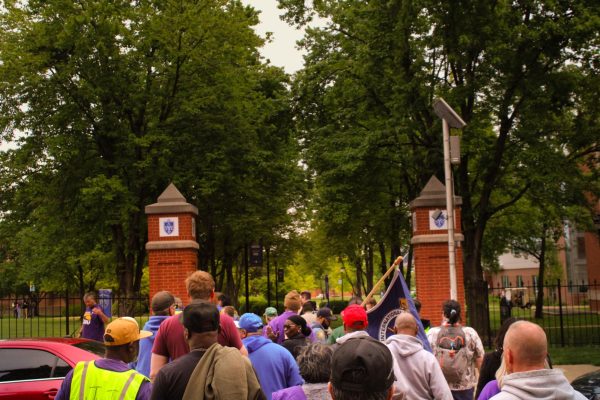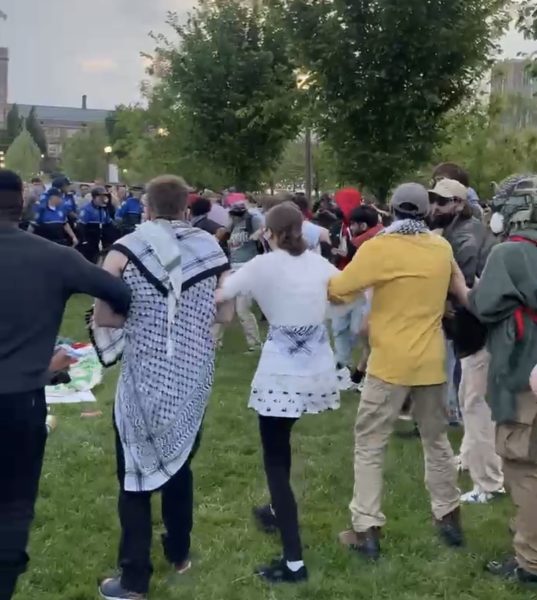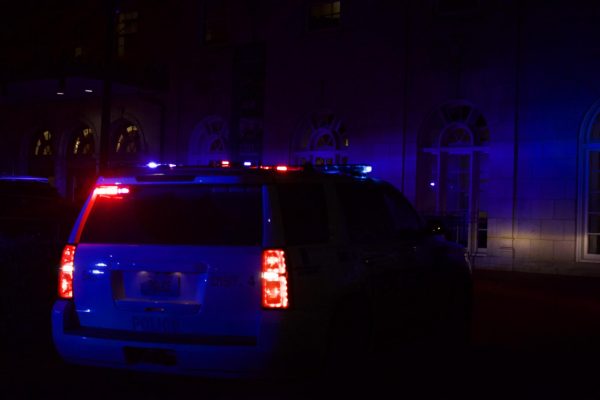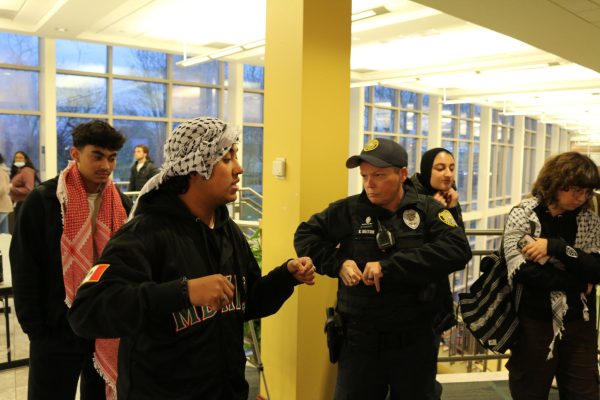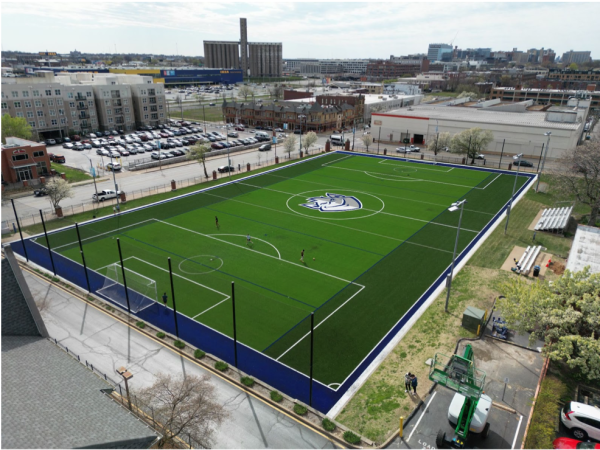Award-winning journalist and Race-Card Project founder Michele Norris delivers speech
Michele Norris, award-winning journalist and founder of the Race Card Project, delivered a keynote speech in the Saint Louis Room of the Busch Student Center on April 4. Norris, who has worked in the journalism field for four decades, began the Race Card Project in 2010, which invites individuals to initiate conversations about race through six-word postcards which described their identity and experiences. Her message is to build bridges through differences.
“I think it is the greatest challenge for the next generation of young people,” Norris said. “In order to lead, you have to figure out how to deal with people who don’t agree with each other and are roaming in different directions.”
The keynote speech was the result of a collaborative effort between the College of Arts and Sciences, the Division of Diversity and Innovative Community Engagement and the Department of Communication. Dan Kozlowski, the chair of the Department of Communication, said that he had thoughts about inviting Norris to SLU since the Spring of 2021. In the aftermath of the murder of George Floyd and the conversations about social justice that followed, Kozlowksi said that he was looking for ways to hold discussions on race, culture and identity within the department.
“A colleague of mine, who then was at Wayne State, informed me that Michelle Norris was visiting there virtually through a Zoom webinar,” Kozlowski said. “I went and listened to Michelle Norris’s presentation at Wayne State, and it was amazing. I wanted to bring Michelle Norris to SLU.”
After attending the webinar, Kozlowski said he began the process of getting approval from the College of Arts and Sciences. Katrina Moore, the associate dean of diversity, equity, inclusion, and engagement, says both the Colleges of Arts and Sciences and DICE also saw that same potential for productive discourse on-campus.
“The six words often tell a story that we don’t know, and that is what makes it very interesting,” Moore said. “It is very important to understand how people see themselves in their own experiences.”
In spite of several complications that arose as a result of COVID-19 variants, the event was finally set for the Spring 2023 academic semester. Kozlowski, speaking about the overall process it took to host Norris’ keynote speech, said that he is grateful for all the help received from Moore and Aubra Ladd, the program coordinator for DICE.
“There’s a lot of moving parts for an event that is just a handful of hours when Michelle Norris is here,” Kozlowski said. “Katrina has been wonderful [to work with], and then Aubra Ladd… [she and DICE] has done wonderful work around campus.”
The Race Card Project presentation on SLU’s campus had begun to occur even before Michelle Norris set foot on university grounds. The three sponsoring organizations shared with the SLU community a form by which students could submit their own six-word stories. From 12:00-1:00 p.m. on the day of the speech, these stories were read anonymously by the Fine and Performing Arts Department at the SLU Clocktower.
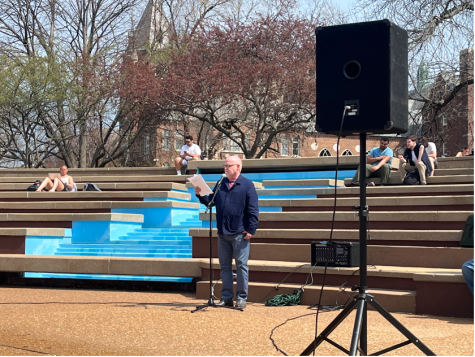
“I think it is important at Saint Louis University, a school that is built on social justice and men, women and persons for others, that we understand how people understand their own experiences and culture,” Moore said. “We have about 127 responses from our SLU community, and we would love to continue this.”
This large partaking in the Race Card Project served as a prelude for Norris’s later keynote speech. The event, starting at 7:00 p.m., saw a mass of students, staff and other members of SLU’s community.
Paityn Upton, a junior student studying social work, said she attended because it represented a chance to engage in meaningful conversation about race.
“One of my teachers for multiculturalism had told us about it in class, and I wanted to come,” Upton said. “It is part of my major… I think it will be a great learning experience for everyone.”
The crowd remained seated as Moore delivered an introduction on Norris and the Race Card Project. When Norris came to the stage after the introductions, she extended her gratitude towards those in attendance and explained why she chose to initiate this project.
“I am a story collector, and I now lean into that second half of my role with a little bit more gusto,” Norris said. “I avoided race for much of my career, and I was a little bit unhappy with how many of the newsrooms I worked in covered race, because it was ancillary.”
Norris, walking across the stage and gesturing to the audience, then went on to describe her observations during 2008, specifically around race, both in the white public sphere’s notion of a “post-racial” society after Obama’s victory and the conversations she was having in her own circles.
“America had entered a really interesting phase… in the public sphere [it] was around this notion that we were entering this new phase of American life,” Norris said. “Post-racial was a word that entered the vernacular with unusual speed, only being used a dozen times in popular culture before 2006… [treating race in] the [same] way you put stuff in a drawer.”
Sharing her skepticism regarding the concept of “being done with race,” Norris turned it over to the audience, enabling an expression of their thoughts, stories and reactions towards this outward perception of racial identity. In a continuation from the early performance at the Clocktower, Norris shared some sample stories from the race card project: “Not comfortable in my own skin,” “I’m not the paralegal, I’m counsel,” “Don’t think of you as Asian” and other stories. As the audience was engaging with these short, yet complex messages of identity, Norris ended with a message of understanding.
“My six words are, ‘Still more work to be done,’” Norris said. “We need to figure out how to listen to each other and build community with each other, even when we don’t agree, and I believe it starts with listening.”
Jennifer Xa-Que, a freshman student, said that this opportunity to engage with the dynamic stories resulting from the Race Card Project was deeply beneficial.
“Just being able to learn a lot from her [was a great experience], it was a really big event,” Xa-Que said.
Speaking after the event had concluded, Norris said to the University News that she found the large turnout for the speech, especially post-COVID, to be quite heartening.
“At a moment where as country we are divided, confused and constricted, I’m glad that people came to listen and share their stories, and they came with questions,” Norris said. “I try to help people see not just my point of view, but introduce them to new ways of thinking… I’m always thinking about blindspots: who am I not hearing from.”
However, harkening back to her own six words, Norris said that there is more that she wishes to do for this project on SLU’s campus.
“I plan on coming back,” Norris said. “I know that [SLU has] done the Race Card Project here, and I think it would be wonderful to work more closely.”
Your donation will support the student journalists of Saint Louis University. Your contribution will help us cover our annual website hosting costs.


